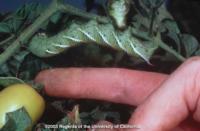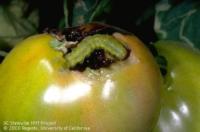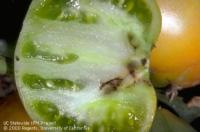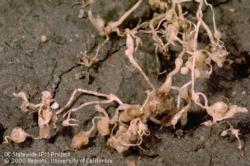Tomatoes, pests
-
Tomato Hornworm
Are tomato leaves disappearing overnight? Your plant probably has tomato hornworms.The tomato hornworm is a large green caterpillar with a distinctive horn on the rear.
Symptoms – leaves and small stems are completely eaten. Green and ripe fruit have gouges in them.
Control - The easiest control measure is to pick them off and dispose of them. Read more about control of the tomato hornworm.Tomato Fruitworm
Do your ripening tomatoes have deep watery cavities as if something is burrowing into them? Your tomato may have tomato fruitworms.Tomato fruitworm (also known as corn earworm) is a small caterpillar up to 1-3/4 inches long with distinct stripes and short hairs. They attack developing fruit.
Damage - Tomato fruitworms bore into fruit and leave deep watery cavities.
Solutions - Handpick. Avoid spraying with insecticides which may leave residues on fruit and destroy natural predators.
Bacillus thuringiensis or Bt, a biological insecticide, may kill most of the population but must be applied just after eggs hatch and before caterpillars enter fruit. Spinosad is another insecticide which may be effective, but is best if sprayed on leaf and fruit surfaces where the caterpillars are feeding. Repeat applications may be required. Follow label instructions exactly when using pesticides.
Important natural enemies of fruitworms include small parasitic wasps. Other garden predators also feed on eggs and larvae. Read more about control of tomato fruitworm.
Tomato Pinworm
Are tomato leaves chewed on and folded together? Do you see small caterpillars? Your plant may have tomato pinworms.Tomato pinworm caterpillars are tiny and have a mottled pattern, usually grey or yellowish in color; some may be dark.
Damage - The pinworms make leaf mines and leaves folded together, where the larvae take shelter. The fruit has holes at the stem end, and blackened tunnels into the fruit.
Solutions - Control is difficult; insecticides and natural enemies are not effective. Remove contaminated plants and rotate crops. Read more about control of tomato pinworm.
Root Knot Nematodes
Are your tomato plants growing poorly, with reduced yields? Are the leaves turning yellow, then brown, from the bottom up throughout the plant? Do the plants look wilted? When you dig it up do you see many beads or swellings on the roots? Your tomato may have root knot nematodes.Nematodes are microscopic, eel-like roundworms. The most troublesome species in the garden are root knot nematodes, which live and feed within plant roots and attack many species of plants, including many vegetables.
Damage - Nematodes cause swellings, called galls, on the roots of the plant. These galls prevent nutrients from reaching the plant and may allow disease organisms to enter the plant. Above ground plant symptoms include wilting even with adequate moisture, yellowing leaves, slow growth, smaller and fewer leaves and fruit.
Control - Control is difficult; prevention is more successful. Plant nematode-resistant varieties. Tomatoes varieties with VFN on the seed packet or nursery tag are resistant to root knot nematodes (as well as Verticillium wilt and Fusarium wilt). Use good sanitation in the garden - clean tools and equipment thoroughly. Rotate crops. For tomatoes in containers, clean pots thoroughly and use fresh soil each season.
Read more about control of root knot nematodes.
Read more about tomato pests.




